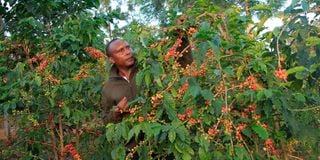Premium
Understanding fertiliser usage on coffee bushes

Charles Munyao at his coffee farm at Muthwani Village in Machakos County on June 18, 2022.
Martin Ngare is the general manager, of Coffee Management Services, an agribusiness service provider. He spoke to Irene Mugo on how farmers can use foliar fertiliser to boost the quality of their coffee berries and yields.
What is foliar fertiliser and how is it different from ground-applied fertiliser?
These are concentrated solutions that are directly applied to leaves. Foliar fertiliser will not replace ground fertiliser. It is only complementary for nutrient uptake. Such a fertiliser satisfies deficiencies the plant may have.
Plants can only absorb small doses of their nutrient requirements through leaves. They absorb most of their nutrients through their roots.
Unlike ground-applied ones, foliar fertiliser provides nutrients where it is predominantly needed – foliage and cherry. It provides rapid and effective nutrient supply during growth when demand is highest.
The fertiliser is formulated to provide specific nutritional requirements. It provides support to plant growth under stress conditions.
It also maintains healthy foliage. It increases resistance to biotic and abiotic stress factors.
How can foliar fertiliser help overcome low yields and produce poor-quality coffee beans?
Low yields are a result of poor soil health, poor agronomic practices, erratic weather and other factors. Applying lime can improve soil health. One can also apply manure to improve organic matter content.
Ground application of fertiliser, complemented with appropriate foliar fertiliser address plant nutritional requirements.
Poor quality beans can be a result of drought, low nutrition, attack by pests and diseases or poor processing. Foliar fertilisation is key during drought. It helps the plant cope with biotic and abiotic stress while giving the much-needed nutrients.
How effective is organic foliar fertiliser compared to inorganic foliar fertiliser?
Organic and inorganic foliar feeds have their place in plant nutrition. Most organic foliar fertilisers will provide the necessary macro-nutrients but quantity and efficiency will vary, depending on the materials used for their preparation.

Martin Ngare, the General Manager, Coffee Management Services Ltd.
Inorganic foliar fertiliser, on the other hand, is specific in the nutrients provided and quantity. In particular, most micro-nutrients such as zinc and iron will require to be chelated through complex chemical processes to be available to the plants.
The chelated micro-nutrients are found in inorganic foliar formulations.
How does foliar fertiliser help in solving the challenge of rising input prices?
As an institution, we have introduced Biofol – foliar feeds that are highly concentrated suspensions containing stickers that prevent nutrients from being washed off by rain.
They also contain agents that prevent the micro-droplets from evaporating before they reach the leaves, thus increasing nutrient absorption.
All micro-nutrients are coated with chelating agents, thereby making them available for uptake by plants.
The products have good miscibility, making them compatible with fungicides and pesticides. This, therefore, means that the farmer is able to apply one solution, thus saving costs.
What is the application formula for foliar fertiliser and the expected production from a coffee crop?
Given that plants can only absorb nutrients in small doses through leaves, the application rate is 20ml to 40ml per 20 litres of water.
When sprayed, this solution covers about 30 trees. Foliar application is done about four times in a growing season.
When all the agronomic activities are carried out as expected, the yield is consistently more than 10 kilogrammes of cherry per coffee tree per year.
Due to years of inorganic fertiliser application, many soils in coffee-growing areas have declined in fertility and have low pH. Can foliar fertiliser help cure the challenge?
The problem of low pH should be addressed through the application of agricultural lime and organic manure as per soil and leaf analysis recommendations.
Foliar feeds only offer supplementary support to the plant by making the nutrients available albeit in small doses if the root uptake is limited due to low pH.





